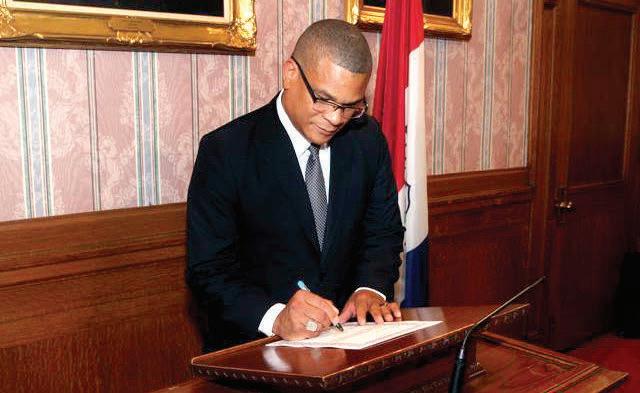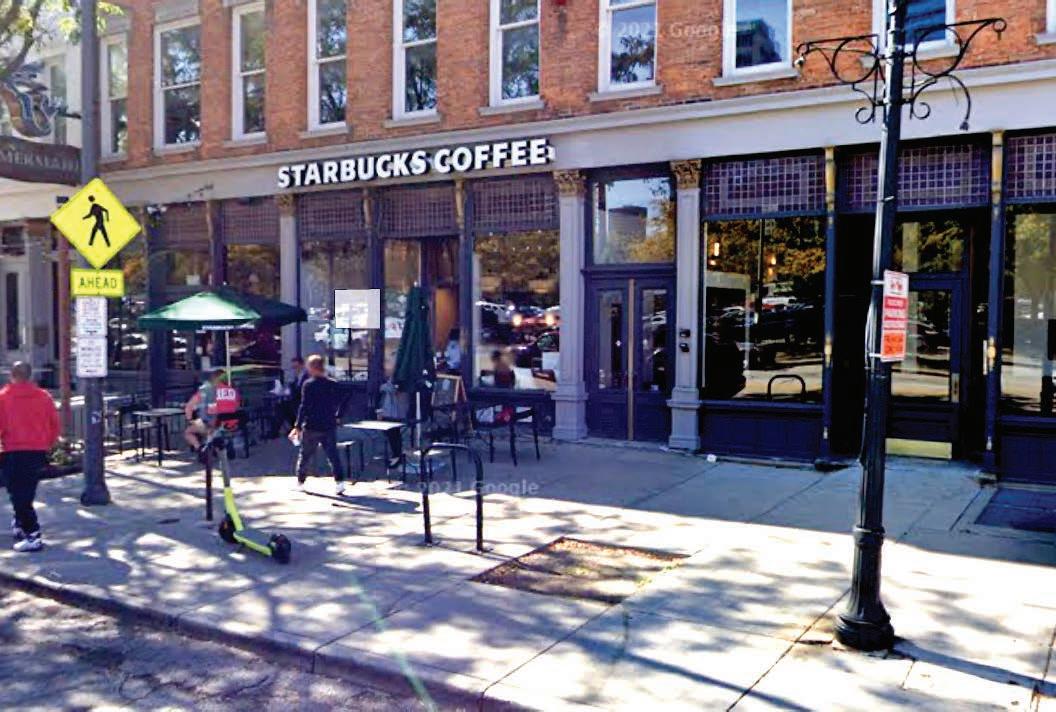
12 minute read
Upfront


Advertisement


UPFRONT UPFRONT



CLEVELAND SAFETY DIRECTOR, POLICE BRASS COORDINATED ANTI-ISSUE 24 MESSAGING
CLEVELAND SAFETY
Director Karrie Howard and former Police Chief Calvin Williams were “on a mission” to inform the public about Issue 24, internal emails reveal. And while they purported to remain neutral in the debate, the information they marshalled and disseminated at community meetings through October represented a coordinated campaign to oppose the controversial ballot measure in the leadup to the Nov. 2 general election.
Issue 24 was the initiative to create a more powerful civilian commission with ultimate oversight in matters of police discipline. It passed overwhelmingly in November. Mayor Justin Bibb, who was formally inaugurated this weekend, supported the measure. It was launched by a local coalition called Citizens for a Safer Cleveland. Opposition from the Department of Public Safety was to be expected, as passage was interpreted as an affront to police autonomy. It was also opposed by Mayor Frank Jackson, mayoral challenger Kevin Kelley and the majority of Cleveland City Council.
According to October emails obtained by Scene via public records request, the police wanted to maintain an air of neutrality on Issue 24.
“Our goal is to inform, not persuade,” Howard wrote in an Oct. 4 message to Calvin Williams and the commanders of Cleveland’s five police districts, coordinating attendance and talking points at upcoming community meetings.
But the talking points Howard favored, and Howard’s own language, demonstrated otherwise.
Howard’s “mission” was set in motion in the aftermath of a Sept. 29 Cleveland City Council Safety Committee meeting. He had spoken with Paul Forsgren, the local man who founded Greater Cleveland Citizens for Public Safety to oppose Issue 24, as well as councilmen Blaine Griffin and Brian Kazy about “raising awareness in the community.”
“With early voting in two weeks, we should begin putting this information into strategic sense to begin messaging next week,” Howard wrote to Chief Williams and Frank Jackson’s communications chief, Valarie McCall, on Oct. 1. Williams agreed, responding that getting the media involved was an important next step.
Howard promptly communicated to the district commanders, encouraging them to schedule and attend community meetings in the coming weeks to address safety concerns generally and Issue 24 in particular. He asked that calendars be shared so that either he or Calvin Williams could attend block clubs and safety meetings to advance the police message.
“We will not take a position [on Issue 24],” Howard wrote, “but will speak with an informative tone and intent.”
The talking points he distributed to his commanders largely concerned the language of the charter amendment itself, highlighting fears that it would remove power from both elected officials and police leadership. Howard and Williams felt that these elements were not being communicated to voters.
Commanders followed up to share meeting dates as they were scheduled. Others asked questions about specific responses to community members. Commander Thomas Stacho, of the Second District, said it would be helpful to see material that the Issue 24 proponents were disseminating to establish a “frame of reference.”
Commander Dorothy Todd, of the third district, sent Howard an email asking how to respond to Alan O’Connell, the President of the Downtown Cleveland Residents Association, who had shared a cleveland.com article with her and asked if she thought it fairly represented both sides of the Issue 24 debate. He wanted to distribute “neutral sources” to his organization’s membership, he said.
In a response to Todd, Howard said that the article, written by
UPFRONT

City Hall reporter Bob Higgs and outlining the positions of supporters and opponents, provided “some info, but not enough of the truth.”
The next day, Oct. 5, Todd responded to O’Connell expressing personal ambivalence about the cleveland.com article and sharing Director Howard’s talking points. Additionally, she attached data showing declining use of force by the Cleveland Police.
Chief Calvin Williams, both in public and private, was keenly interested in promoting this data. He believed that the Division of Police’s improvement under the consent
DIGIT WIDGET
207 inches
Circumference of a Black Walnut tree in the Metroparks that was recently cut down by a brother and sister who believed it was on their land. They’ve now been charged with theft of the tree, one of the oldest of its species in Ohio, and valued at more than $25,000.
7’0”
Height of Warrensville Heights Mayor Brad Sellers, who formally entered the 2022 race for Cuyahoga County Executive last week.
5’6”
Height of former Cleveland mayor and Congressman Dennis Kucinich, who sued Cleveland. com and The Plain Dealer last week for what he claims was libelous 2021 election coverage.
$186,000
Debt accrued by Akron alternative publication The Devil Strip, which abruptly laid off its entire staff late last year and now appears to be done for good. decree was evidence that Issue 24 was unnecessary. The declining use of force and reduction in citizen complains was “an important narrative that the community needs to hear,” Williams wrote in an email to Howard.
This was a narrative advanced by the Cleveland Police Patrolmen’s Association as well. In a “No on Issue 24” mailer paid for by the CPPA, President Jeff Follmer penned a four-paragraph letter to residents, outlining the main points of opposition.
“Issue 24 is being sold as providing necessary oversight of a Division that lacks accountability and discipline,” the mailer read. “Nothing could be further from the truth. During the past six years of reform under the Consent Decree, both accountability and discipline have reached all-time highs. The Office of Professional Standards and the Civilian Police Review Board have been transformed into an effective investigator of citizen complaints.” (That position is undercut by a recent report by the Consent Decree Monitor, Hassan Aden, which found “an overall, systemic failure” in the investigation of the police chase that resulted in Tamia Chappman’s death.)
Follmer’s letter concluded by saying he stood with “the Mayor, the Safety Director, the Chief and the council members with whom I have spoken against Issue 24.”
Though the October emails Scene reviewed showed no direct coordination between the Department of Public Safety and Kevin Kelley’s mayoral campaign, Steven Rys, Kelley’s longtime operative and aide, does make an appearance. On Oct. 12, he sent an email to Howard asking to be sent a copy of the data that had been assembled in the aftermath of the Sept. 29 Safety Committee meeting.
“In specific, Chief Williams made a number of claims about the positive impacts of the Consent Decree and the police reform the city has undertaken thus far,” Rys wrote. “Any information you had about the reduction in the number of complaints, the reductions in use of force, the reduction in police involved shootings, etc would be very useful.”
On October 11, Howard and Commander Stacho attended a meeting of the Lincoln Heights block club in Tremont, held at the Tremont Taphouse. Howard took time at the beginning of the meeting to go over a flyer he’d brought, which hardly could be mistaken for a neutral document.
It began by calling Issue 24 a “problematic proposal that stands to make attorneys a lot of money at taxpayer expense.”
Both the tone of the flyer and its anonymous authorship didn’t sit well with some of the block club’s members. Developer Josh Rosen, who couldn’t attend the meeting but was sent a PDF of the flyer the following day, had a testy exchange with Commander Stacho — an exchange that was forwarded to Howard and police leadership — after he inquired into the authorship of the document.
“I have no idea who created that paper and I had not read it until a few hours ago. I have not studied it,” Stacho wrote back to Rosen. “Is there anything in that document that is incorrect or misleading?”
Rosen said that he didn’t know, only that he was skeptical of unsigned political literature and that much of the language sounded more like opinion than fact.
“I think if/when [the flyer] comes from a group like the police, assuming it did, it hits even worse since we should have complete trust in what they represent and be able to separate fact from opinion,” Rosen wrote. “I think police are very entitled to their opinion—no different than me being entitled to mine—just that if it is going to be distributed, it should be signed and the author should be noted.”
“Once again, I have no idea who authored that piece and it did not come from me or my office,” Stacho responded. “I only read it today after it was handed to me at a separate meeting. I am sorry that you have decided that someone in the Division of Police authored that document. Clearly an agenda on your part.”
Rosen told Scene that his suspicions weren’t unfounded. He’d been informed by the block club president that Howard brought the handouts personally and went over their contents “paragraph by paragraph” during the meeting. The assumption by the attendees was that Howard himself was the author.
In fact, in an Oct. 13 email from

Howard to Deputy Police Chief Joellen O’Neill, Howard says that the version of the one-pager distributed at the block club meeting was “given to me.” It’s unclear in the emails who gave it to Howard, but the safety director had previously sent the one-pager to Ward 7 Councilman Basheer Jones. It included the talking points he distributed to commanders on Oct. 1. O’Neill had drafted another version to be distributed to district commanders for their use, but preferred the version Howard sent her.
“Yours is much better,” O’Neill wrote.
Responding to inquiries from Scene, Director Howard provided the following statement.
“The citizens of Cleveland voted for and passed Issue 24. It is now part of the City’s Charter. My entire legal career has been dedicated to the rule of law and reform of the justice system, to include police reform. I remain dedicated to my obligation to uphold the law and carry out my duties in support of the Charter of the City of Cleveland. As the City’s Public Safety Director, I look forward to doing my part to advance the incoming administration’s vision for public safety and working with the new commission.”
-Sam Allard
Employees at W. 6th Starbucks Take First Step Toward Unionization

Employees at the W. 6th Starbucks location in downtown Cleveland have petitioned the National Labor Relations Board (NLRB) for a union representation election. The Cleveland Starbucks would be the first Ohio store to unionize and follows similar efforts at locations across the country, including in Boston, Buffalo, Chicago, Seattle and elsewhere.
In a letter to Starbucks CEO Kevin Johnson sent Monday morning, workers at the W. 6th store said that while they served at the forefront of the customer service industry during the pandemic, they haven’t felt adequately cared for. With insufficient guidelines and safety measures, disillusionment and burnout are now commonplace.
Starbucks workers are euphemized as “partners” in the corporate lingo, but workers say that during the pandemic, they’ve felt more like “cogs in a machine.”
“We see unionizing as the best way to achieve true partnership, beyond just the title of ‘partner,’” the letter reads. “Through this union, we are committing to our goals of improving our own work lives, establishing equity and equality within our store and the company, and doing our part to move the company forward. By signing onto these principles, Starbucks can prove itself as a partner alongside us in this commitment.”
Cara Rovella, 22, is a barista and barista trainer at the W. 6th location. She started working at the popular coffee chain in July of this year. She told Scene that she signed a union authorization card, along with the overwhelming majority of her colleagues, for a number of reasons.
“A lot of people say Covid is the big reason,” she said, “because we feel let down by the safety measures put in place by our company during the pandemic. But I personally am a barista trainer, and the training plan simply doesn’t provide enough time to really teach people how to become a barista.”
Wages are another reason, Rovella said, both the base pay and the raises for longtime employees.
“The crux of all these issues is that we just want to have a voice,” Rovella said. “Decisions at Starbucks are made in a top-down manner. We just have to do what they tell us. But we’re the ones on the ground, working with the public. And we don’t think it’s realistic or fair that we don’t have a say in how things get done.”
Rovella said that the unionization process has moved extremely quickly, and that local workers were inspired by the unionization effort at the Buffalo location.
“That made us think, if Buffalo can do it, maybe we can too,” she said. “Once these things started to happen, people began to see the possibilities for themselves.”
Rovella said that she suspected Starbucks wouldn’t voluntarily approve the union in Cleveland and that, if Buffalo were any guide, corporate would work to delay the vote and lobby against the unionization effort by a number of means. But when the National Labor Relations Board holds the vote, a simple majority of the location’s 20 workers is all that will be required to form the union.
“At the end of the day, we all like working for Starbucks and are doing this because we’re dedicated to the work and want to make the jobs better,” Rovella said. “I hope this can set the stage for others in the region, and that people will start to think, ‘Hey, we don’t have to endure unfair treatment. We can stand up for ourselves.’”
clevescene.com



